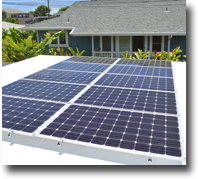Akamai Energy - Solar Photovoltaic - Honolulu, Hawaii
News Item- Powered by MBC NewsMaker
Hawaiian Electric Companies implement changes to help more customers add solar photovoltaic systems
- Tweet
 FOR IMMEDIATE RELEASE
FOR IMMEDIATE RELEASE(Honolulu, Hawaii) -- Hawaiian Electric, Maui Electric and Hawaii Electric Light Companies are making procedures easier, faster and less expensive for customers seeking to add rooftop solar photovoltaic (PV) systems, while continuing to ensure safe and reliable service for all customers.
"Hawaii's utilities lead the nation in percentage of customers who have PV," said Scott Seu, vice president for energy resources and operations. "It's a big contributor to achieving our state's renewable energy goals and we know it's an important option for our customers to help reduce their electric bills.
"At the same time, as our customers add more solar systems, circuits on all islands are reaching the level of PV that requires added care to maintain safety and reliability for all customers. But with additional studies and more experience, we are making changes to minimize the times when an interconnection study may be needed and making it as easy as possible for customers in cases when a study is needed."
The Hawaiian Electric Companies are changing the threshold so more small systems (10 kW and under) can be added without a potentially costly and time-consuming interconnection study. The new threshold for a possible interconnection study is 100% of the daytime minimum circuit load, increased from 75%. In addition, Hawaiian Electric is doing a limited number of studies on several representative circuits and will apply the results to as many projects as possible on similar circuits. Previously, each project requiring a study would have to go through its own separate study. This new approach will greatly reduce the number of studies needed and reduce costs to customers.
Hawaiian Electric is also asking all Oahu residential and commercial customers planning to add rooftop solar to call or email the utility before signing a contract or beginning installation. Maui Electric and Hawaii Electric Light already ask customers to contact them before initiating a solar project, as does Kauai Island Utility Cooperative.
In this way, a customer or contractor can get the most up-to-date status of the circuit on which they propose to add a solar project. Depending on how much PV is on the circuit, the utility may perform a supplemental review at the utility's expense to determine if a more extensive study is required. Customers or contractors must still submit and get approval for a completed net metering application to connect to the grid and get the financial benefits of net metering.
"We want to avoid the situation where our customer signs a contract for PV or starts installation and later learns about added costs for studies or circuit upgrades because the circuit already has a high amount of PV," said Seu. "We are making changes to make adding solar faster, cheaper and fairer, but we do ask customers to call so they have the most current information when making a decision about a very big financial investment in improving their homes or businesses.
"As we continue to monitor circuits and do representative studies we anticipate that it will be possible in the future for even more small systems to go forward without an interconnection requirements study," Seu said.
Solar installations in Hawaii have doubled yearly since 2008 and are on track to double or nearly so in 2013. No other utility in the nation has seen this dramatic growth. With more than 32,000 PV systems installed with a capacity of more than 240 megawatts interconnected, Hawaii utilities lead the nation in solar watts per customer and in the percentage of customers who have rooftop solar.
Background:
Too much solar power connected to a circuit without proper protective equipment is dangerous. The resulting back-feed can endanger the lives of utility workers and cause poor electric service, from flickers to outages. Over-voltage from high levels of solar can damage sensitive customer electronics including computers and televisions. Over-voltage can also damage utility lines and transformers. Interconnection studies are performed to identify what types of upgrades can be installed on a circuit to prevent these problems.
Please send questions about this website to webmaster
Terms of Use / Legal Disclaimer / Privacy Statement
Site Designed and Managed by MacBusiness Consulting
